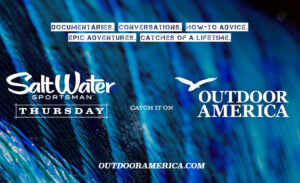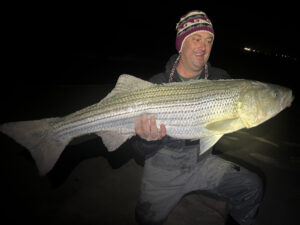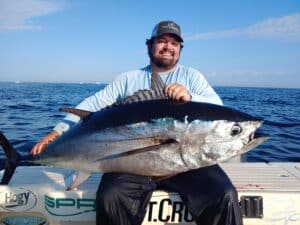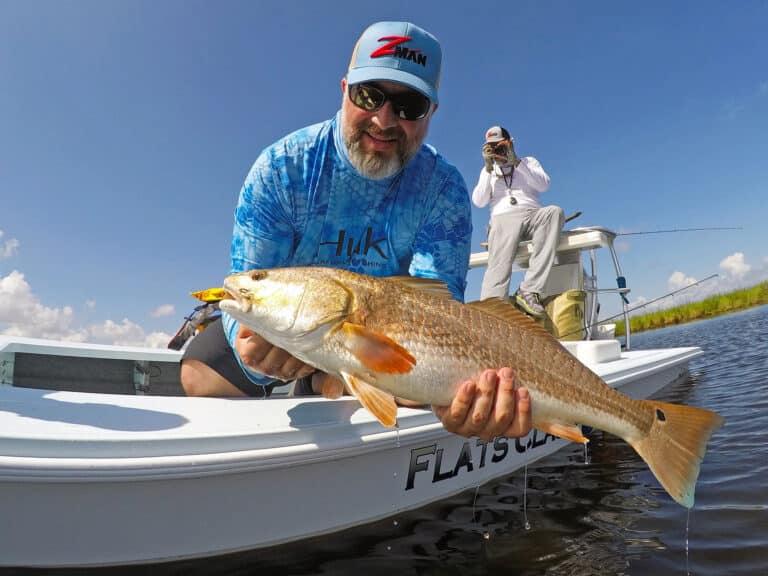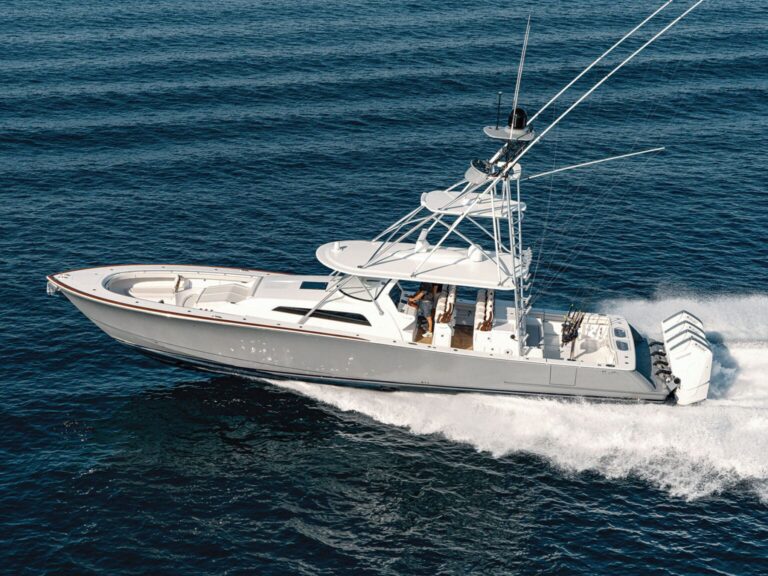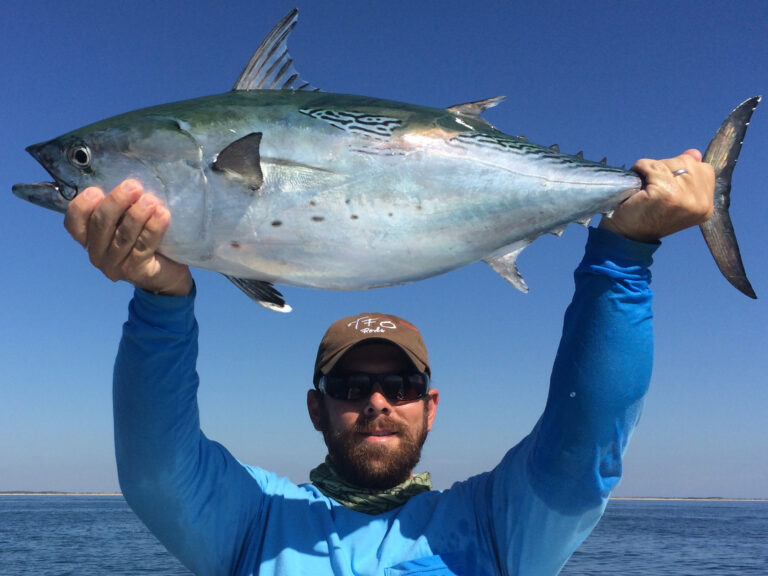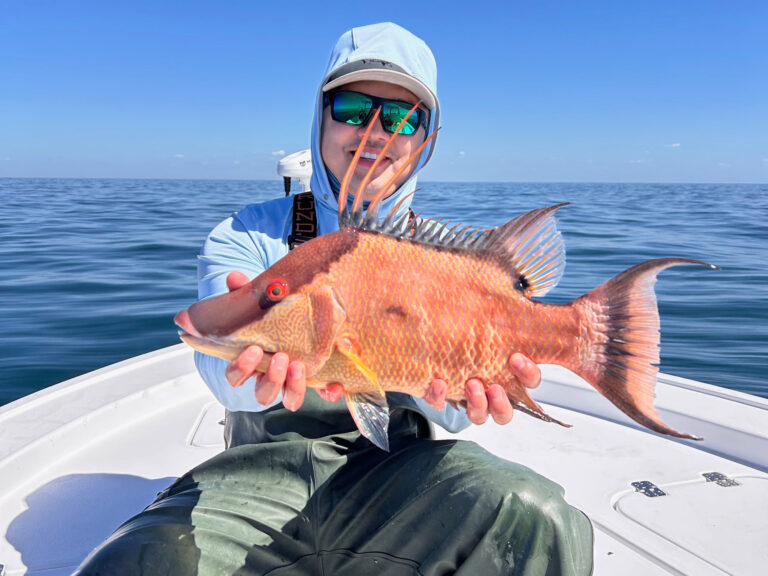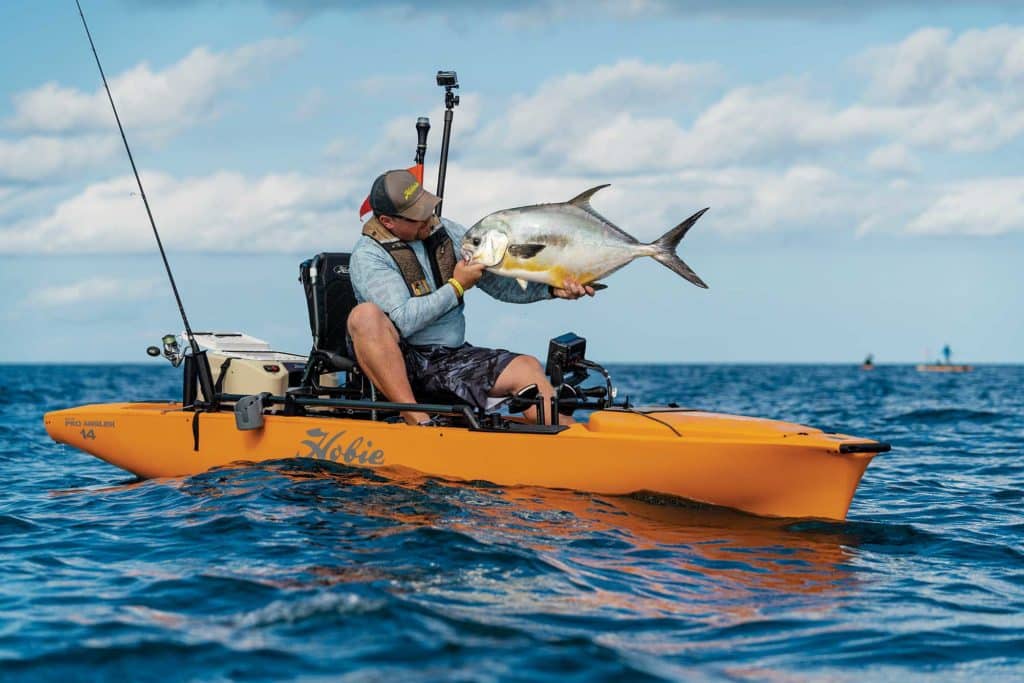
Line tumbled off the open spool. I shifted my body weight in the direction of my rod tip while sliding fully upright on the mesh seat of my Hobie kayak. I set my shoulders as I neared the end of my five-second countdown.
Closing the bail on my reel, I watched the line pull tight. As the rod tip bowed heavily toward the chop lapping against my hull, I reeled and lifted, driving the circle hook firmly into place. Immediately I felt the weight and wide body of my target species, a large and very angry offshore permit.

I was fairly certain I had hooked what I was after. During late April, only a handful of fish readily gobble a live, 3-inch blue crab suspended midwater over the offshore wrecks of southwest Florida.
I adjusted my kayak rudder to steer the bow opposite the permit’s direction. This additional surface drag allowed me to pull deep into the rod. I slowly and methodically played tug of war against this heavyweight.
I began pedaling the kayak away from the underwater structure: an old shrimp boat that had found its final resting place in nearly 60 feet of water, about 14 miles off Sanibel Island on Florida’s Gulf Coast. As I gained distance from the wreck, the fish quickly shifted directions. I spun the rod behind my head, switching hands as the permit sped from port to starboard.
Finally, the endgame: a vertical seesaw battle. After 10 minutes, I saw a flash about 20 feet below. “We’ve got color!” I shouted to my fishing partner, Hobie’s Morgan Promnitz. The bright-silver body of a 20-pound permit shimmered in the green water.
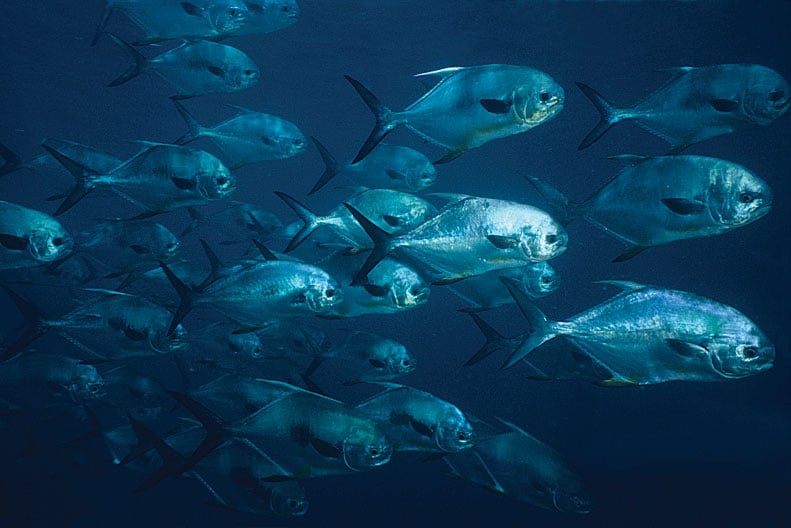
Hitch a Ride
The popularity of kayak-fishing has exploded over the past decade, bringing more-adventurous anglers into the sport. After years of successfully targeting easily accessible species, some of us have sought harder-to-reach targets that swim far beyond the daily travel range for most fishing-style kayaks. This desire has created a niche market for local captains and anglers piloting larger center-console boats who can reach distant destinations with kayaks aboard or in tow.
In fact, as a southwest Florida transplant of nearly 15 years, I’ve targeted a majority of our inshore and nearshore species from my ’yak. While tarpon, sawfish and inshore grouper challenged me, the one species I’ve wanted to knock off the bucket list is permit.
Permit aren’t especially difficult to catch in our local waters, but successfully landing one of these fish by kayak requires some advanced planning and the assist of a mothership. Locally, these full, eight-hour day trips can cost $750, which includes a livewell full of crabs. I’ve only occasionally needed a powerboat to reach the fishing grounds. The first time, I was in an isolated portion of jungle along the Panamanian coastline. The second time: this permit trip.

I could have spent an extremely long day trekking to some shallower wrecks 8 to 10 miles offshore. But employing the help of Capt. Matt Johnson and his 24-foot Blue Wave bay boat made the experience all the more enjoyable.
Johnson picked us up from our launch point at South Seas Island Resort. Our group of two anglers, one videographer and a photographer had gathered there with the ultimate goal of capturing permit from the local shipwreck offshore of the barrier islands.
It took a bit of muscle, but we loaded our three Hobie Pro Anglers aboard the center-console at the marina dock. We lashed the 14-foot kayaks alongside the gunwale, two on the port side and the third to starboard. With calm seas expected, we felt comfortable making the long haul offshore.
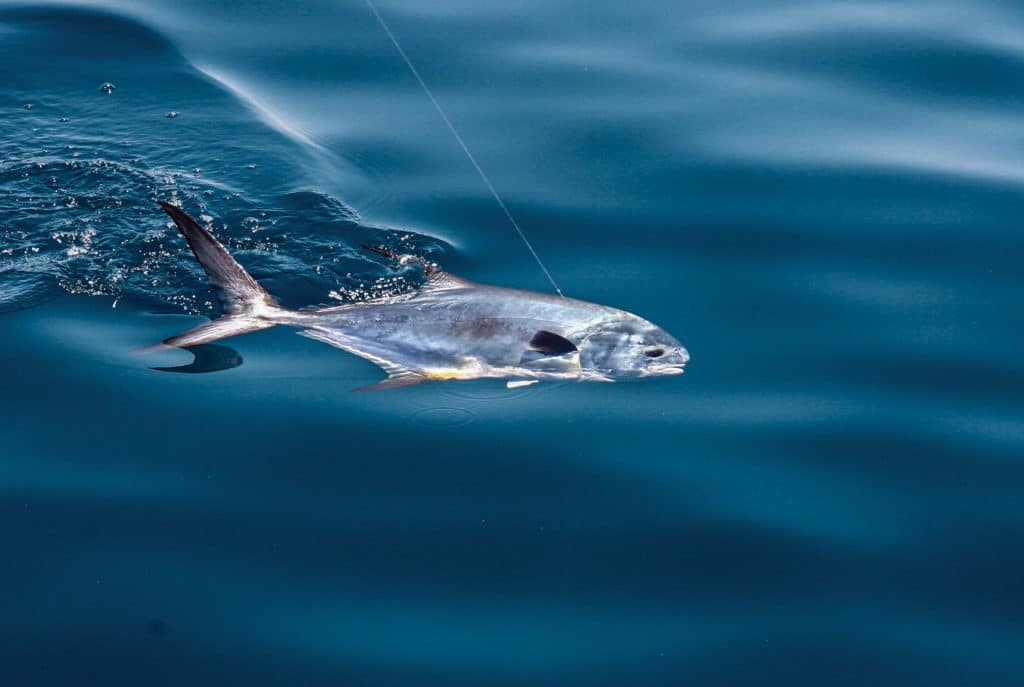
Crab Bounty
Beginning in March, from the Ten Thousand Islands to Boca Grande, massive aggregations of adult permit head offshore to feed and spawn. Schools can number into the thousands of individuals. Anglers often see these permit swimming with their dorsal fins breaking the water’s surface.
The fish begin venturing into local regions as the water temperatures hover around 75 degrees. They can be found in wrecks as shallow as 20 feet, just a few miles offshore, or as far out as 50 miles or more, in wrecks over 100 feet deep. Fortunately, this migration continues into early fall, with permit still available until the first cold fronts arrive in late October.
The spring movements coincide perfectly with the spring crab flushes that pour from the coastal waters of Pine Island Sound and Charlotte Harbor. For several months, millions of crabs float along the surface during outgoing tides. They drift in masses to offshore waters on their own spawning journey, much to the delight of hungry permit.
Read Next: Tarpon on the Dark Side — Fishing Florida After Hours
Prevailing winds tend to dictate how shallow you can find the permit schools. The shallowest and most accessible wrecks hold fish, but often only during a period of light winds. Once the turbidity kicks up in those shallow locations, permit head farther offshore. They find more-comfortable conditions in 40 to 60 feet depths, where the water clarity generally remains more stable.
Fortunately, for anglers looking to target their first permit, the coordinates for artificial reefs can be easily found with a quick online search. Such publicized locations might receive more pressure, but they can still be quite productive when the boat traffic subsides. Private wrecks can offer more solitude, but their locations often remain a closely guarded secret.
Spin Up
Fortunately, targeting these offshore permit involves pretty standard gear. For smaller permit, commonly found in shallower waters, you can use any 3000- to 5000-size spinning reel spooled with 20-pound braided line. I like to pair that with a 7-foot medium-weight rod — probably similar to an outfit for catching flats redfish and snook.
If you’re lucky and follow through on proper planning, you might encounter the largest permit — 40 pounds or more — that haunt the deeper structures. To target those fish, upgrade to heavier gear to keep them out of structure.
My favorite setup is a 6000- to 8000-size spinning reel spooled with 30-pound braid. Bump up to a medium-heavy or heavy 7-foot spinning rod with some serious backbone. Half the effort in catching larger permit comes during the vertical battle. A stout rod quickly proves handy.
Line-shy permit require lightweight fluorocarbon leaders. I start with a 40-inch section of 25-pound-test fluoro, and go down to 20- or even 15-pound-test if fish are around but not feeding. If the bite is aggressive, you can sometimes get away with bumping up to 30- or 40-pound leader. Often, the lighter leader can create at least a few opportunities versus none.
I don’t use any fancy knots for light-tackle permit fishing. A standard uni-to-uni-knot connection works great between line and leader, and shouldn’t fail with the lighter drag pressure you need to use during a battle.

Match the Hatch
Few fish seem as picky as an old permit on our offshore wrecks. I’m an avid artificial-bait angler and rarely use natural or live offerings. However, I do make an exception when targeting these permit. They focus on crabs and rarely look at other offerings.
You occasionally can hook up on shrimp- or crab-imitating lures. More often, though, you’ll see hundreds of fish swimming around your lure without the slightest interest.
Permit anglers find two options for live crabs during the spring migration in southwest Florida: blue crabs and pass crabs. Blue crabs dominate the scene early in the season and make for excellent bait. The best-size crabs for offshore permit measure two to three fingers in width. Permit tend to ignore larger crabs.
Pass crabs, also called iridescent swimming crabs, can be used later in the season. They’re smaller and more delicate than blue crabs but can work pretty well if that’s all that’s available.
Most reputable tackle shops in southwest Florida sell crabs, but be prepared to fork over $2 to $4 apiece. If you’ve got plenty of time, you can dip-net crabs yourself near the local passes — such as Redfish and Captiva — during spring outgoing tides.
Crabs can be kept alive for several days by removing all but an inch or so of water from a five-gallon bucket. Add a cloth towel to the bucket to allow the crabs dry space. Make sure to clean the water every day or so to remove waste.
I prefer to rig crabs one of two ways: With a snelled 1/0 to 2/0 Mustad 2x circle hook, pierce them sideways through the corner of the horn that protrudes from the side of the body, allowing for a nice sideways swimming motion along and just below the surface. Or place the hook between the fold of their abdominal flap and the smallest rear leg. Run the hook point about 1/8 inch from the edge of the shell, going through the crease on the belly and exiting through the top of the shell. Don’t go too far into the body or you’ll injure their organs and cause them to perish quickly.
A properly hooked crab should swim freely on an open spool and last for repeated casts before it expires. If you notice that your crab isn’t swimming much but is still alive, remove it from the hook and put it back in the livewell. Lively baits work best, but as you run lower on bait, those sluggish-but-still-alive crabs can draw bites from frisky permit.
Stealth Approach
Permit swim throughout the water column. At times, they sun themselves on the surface, making a relatively easy target. Approach these fish quietly. A revving outboard or deck hatch slamming can push them down quickly.
When fish visibly fin on the surface, an unweighted circle hook keeps the crab positioned in the strike zone. Use a light sweeping motion of the rod to move a few feet of line and keep the bait near the surface. Gently feather your line and allow the crab to swim naturally with the wind or current.
To maximize your fishing time, position your kayak upwind and slightly off the school. Cast at the school while working toward them. I often deploy a ¼-ounce jig head when fish hold deep, or on windy days when the surface chop makes it difficult to keep track of the crab’s movement.
Pay close attention to your fish finder while navigating around the wreck. A permit school often hangs on one side of the structure, usually at midwater. If you see a cluster of suspended fish on the screen, odds are you’ve located permit.
Cast your jig-and-crab combo up-current and ahead of where you mark the school. Keep in mind that the light jig head will sink slowly toward the strike zone, taking 30 to 40 seconds, depending on depth.
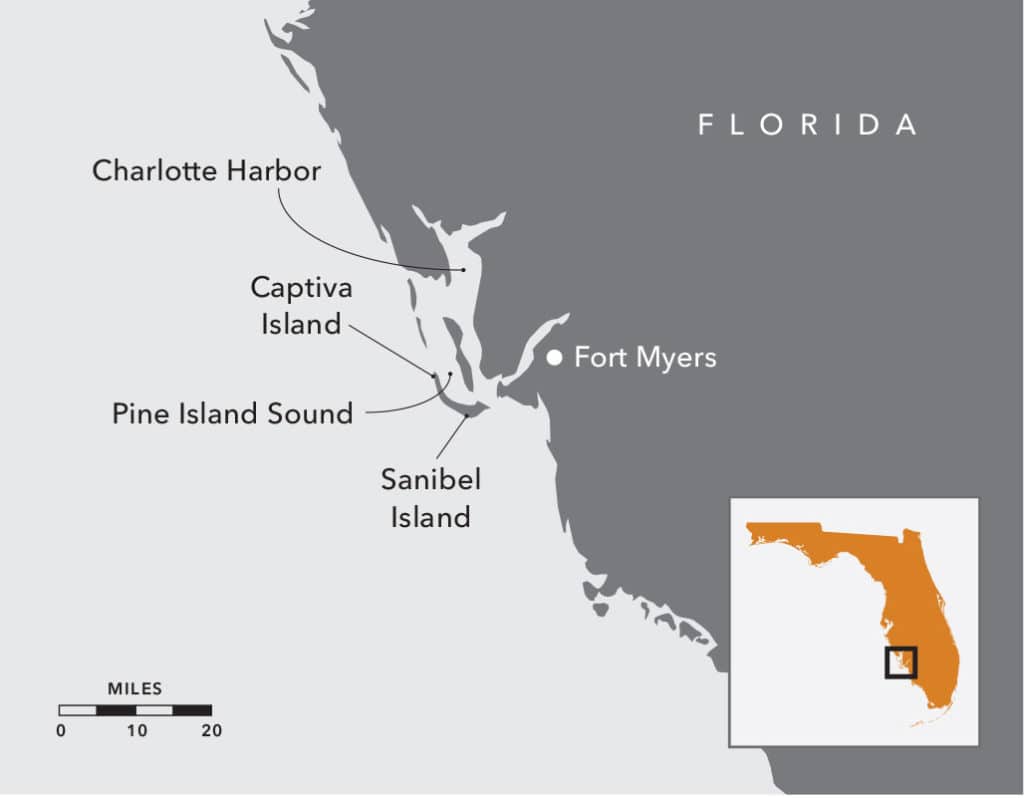
One Fine Day
Our time on the water flew. By late afternoon, the sea breeze kicked up, and my shoulders began to feel the dozen permit I had landed on light tackle. As I was sliding into the afterglow, I saw Promnitz hook up again. He was a glutton for punishment and was taking advantage of every moment we had left on the water.
After he landed his final fish and we snapped some celebratory photos, we high-fived and called it a very successful outing. Covered in salt, sweat, and a bit of permit slime and crab juice, we pulled alongside Johnson’s boat and began loading the kayaks back on deck. I’ll always think back to that first subtle, quick tick of the line — my first kayak permit — a memory that will last a lifetime.
Sanibel Sources
Endless Summer Charters
Fort Myers, Florida
239-691-1966
sanibelislandfishingcharters.com
Tween Waters Inn Resort & Spa
Captiva Island, Florida
800-223-5865
tween-waters.com
South Seas Island Resort
Captiva Island, Florida
239-472-5111
southseas.com
Anderson’s Tackle Shop
Fort Myers, Florida
239-334-3474
andersontackle.com
Whitney’s Bait and Tackle
Sanibel Island, Florida
239-579-0399
whitneysbaitandtackle.com
Tip: While you’re there, try the great shore-fishing opportunities. Check out Blind Pass for snook and redfish, and Sanibel Causeway for snook and tarpon.
About the Author
Capt. Ross Gallagher has fished the waters of southwest Florida for nearly 15 years. An avid kayak angler, he frequently pursues big-game species on his custom-outfitted Hobie Pro Angler 14. You can follow his fishing adventures, product reviews and exciting fishing videos on his blog at theintrepidangler.com.


